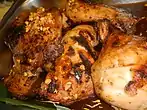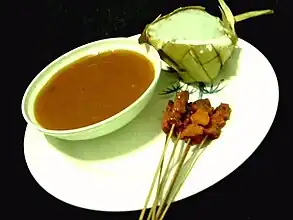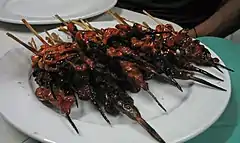Inihaw
Inihaw (pronounced [ɪˈni:haʊ] ee-NEE-how), also known as sinugba or inasal, are various types of grilled or pit-roasted barbecue dishes from the Philippines. They are usually made from pork or chicken and are served on bamboo skewers or in small cubes with a soy sauce and vinegar-based dip. The term can also refer to any meat or seafood dish cooked and served in a similar way. Inihaw are commonly sold as street food and are eaten with white rice or rice cooked in coconut leaves (pusô). Inihaw is also commonly referred to as Filipino barbecue or (informally) Pinoy BBQ.[1][2][3]
  | |
| Alternative names | Sinugba, Inasal, Ihaw-ihaw, Sugba-sugba, Filipino barbecue, Pinoy BBQ |
|---|---|
| Place of origin | Philippines |
| Similar dishes | Inasal, Lechon manok, Satti, Satay |
Description
Inihaw is a general term simply meaning "grilled" or "roasted" in Tagalog, from the verb ihaw ("to grill"). It is also known as sinugba (verb sugba, "to grill") in Cebuano,[2] and inasal (verb asal, "to roast in dry heat, to skewer") in both Cebuano and Hiligaynon.[4][5] It may also be referred to simply by the English name "barbecue" (usually shortened to "BBQ"), especially for inihaw served in skewers.[6][7][8] In other languages of the Philippines, inihaw is known as nangnang or ningnang in Kapampangan,[9] tinúno in Ilocano,[10] and inkalot in Pangasinense,[11] among others.
Inihaw are usually made with pork, chicken, beef, or seafood. Cheap versions can also be made with offal.[1][12]
There are two general types of inihaw. The first are simply meat or seafood grilled directly over charcoal. They are characterized by a charred smoky exterior while remaining moist on the inside. They are usually cubed before serving, and are dipped in various sauces made with a mixture of soy sauce (or salt) and vinegar with fresh red onions, labuyo chilis, calamansi, fresh tomatoes, ground black pepper, and/or sugar. The second type of inihaw are meat or seafood dishes cooked and/or served on a skewer. These include whole roasted animals or cubed meat. Both types may be marinated before cooking and may also be basted while cooking.[3][13]
The marinating sauce is usually similar to the sauce used for dipping. In skewered inihaw, they are also commonly marinated or basted in a sweet sauce which uses banana ketchup and annatto (achuete) oil which turns them a bright red or orange color. More southern versions known as satti are also served with a peanut-based sauce, similar to satay.[14][15]
In Visayan-speaking regions, a common combination is "sinuglaw", which combines pork inihaw (sinugba) and kinilaw (raw cubed fish in vinegar and citrus juices).[16][17]
Variations

Dishes which are types of inihaw but commonly considered to be distinct include the following:[3]
- Lechón – spit-roasted whole pig, usually stuffed with spices and lemongrass.[3]
- Chicken inasal – a version of lechon manok from the Western Visayas, chicken marinated in a mixture of calamansi, pepper, coconut vinegar and annatto, then grilled over hot coals while basted with the marinade. It is served with rice, calamansi, soy sauce, chicken oil and vinegar (often sinamak vinegar, a palm vinegar infused with garlic, chili peppers and langkawas).[18]
- Lechon manok – spit-roasted chicken dish made with chicken marinated in a mixture of garlic, bay leaf, onion, black pepper, soy sauce, and patis (fish sauce). The marinade may also be sweetened with muscovado or brown sugar. It is stuffed with tanglad (lemongrass) and roasted over charcoal. It is typically eaten dipped in a toyomansi or silimansi mixture of soy sauce, calamansi, and labuyo chilis. It is paired with white rice or puso and commonly served with atchara pickles as a side dish. It is a very popular dish in the Philippines and is readily available at roadside restaurants.[19]
- Satti – are usually grilled beef or chicken served on skewers from Mindanao. It is related to the satay and sate of Indonesia and Malaysia. They are usually eaten with ta'mu (rice cooked in coconut leaves, pusô in other Philippine languages) and a bowlful of warm sauce which is usually peanut-based.[7][14]
- Isaw – a type of very cheap skewered inihaw made from pig or chicken intestines. They are cooked and eaten in the same way as meat inihaw.[20] Other types of offal-based inihaw are also eaten, usually with humorous names due to their crude resemblance to various everyday objects. They include "walkman" (pig's ears), "betamax" (cubes of pork blood), "helmet" (chicken head), and "adidas" (chicken feet).[1]
Gallery
.jpg.webp) Inihaw na baboy (pork)
Inihaw na baboy (pork) Inihaw na manok (chicken)
Inihaw na manok (chicken) Inihaw na pusit (squid)
Inihaw na pusit (squid) Inihaw na bangus (milkfish)
Inihaw na bangus (milkfish)_with_dipping_sauce%252C_Philippines.jpg.webp) Inihaw na liempo (pork belly) with dipping sauce
Inihaw na liempo (pork belly) with dipping sauce Lechon manok served with pusô
Lechon manok served with pusô

 Inihaw na atay (pork liver)
Inihaw na atay (pork liver)
%252C_Philippines_02.jpg.webp) Inihaw na panga (tuna jaw)
Inihaw na panga (tuna jaw)
See also
References
- Macatulad, JB. "4 Things to Know About Street Food in the Philippines". World Nomads. Retrieved December 13, 2020.
- "Sinugba". Eat Your World. Retrieved December 13, 2020.
- "10 Best Filipino Inihaw Recipes – Must Try!!". Panlasang Pinoy Recipes. Retrieved December 13, 2020.
- "Inasal". Binisaya.com. Retrieved February 12, 2021.
- Salcedo-Sillesa, Yolanda. "Chicken Inasal à la JT's : Bacolod-Style Grilled Chicken Recipe". Havenhill Cuisine. Retrieved December 13, 2020.
- Ellen Brown (June 14, 2016). "Smart Cooking: Philippine cuisine shaped by many influences". Providence Journal. Archived from the original on February 8, 2017. Retrieved February 8, 2017.
- Jimenez, Gidget (2015). All About the Philippines: Stories, Songs, Crafts and Games for Kids. Tuttle Publishing. p. 59. ISBN 9781462917259. Archived from the original on June 9, 2020. Retrieved September 5, 2016.
- Raichlen, Steven. "Filipino Satti". Barbeuce! Bible. Archived from the original on January 2, 2017. Retrieved September 5, 2016.
- Forman, Michael Lawrence (1971). Kapampangan Dictionary. University of Hawaii Press. doi:10.2307/j.ctv9hvskw.
- Rubino, Carl R. Galvez (1998). Ilocano: Ilocano-English, English-Ilocano: Dictionary and Phrasebook. Hippocrene Books. ISBN 9780781806428.
- "The North Vista". Sunday Punch. Retrieved July 21, 2023.
- "Inihaw na Manok". Eat Your World. Retrieved December 13, 2020.
- "The Happy Home Cook: Inihaw na Baboy (Grilled Pork)". Positively Filipino. Retrieved December 13, 2020.
- "Unique Flavors of Western Mindanao: Satti". Archived from the original on December 17, 2014. Retrieved January 15, 2015.
- Edgar Soon (2009). Pairing Wine with Asian Food. Monsoon Books. ISBN 9789814358941. Archived from the original on June 9, 2020. Retrieved June 9, 2020.
- "Sinuglaw". Panlasang Pinoy. Retrieved September 24, 2019.
- "Sinugba at Kinilaw". Lutong Bahay. Retrieved December 13, 2020.
- "Manokan Country". Unofficial Guide, Philippines. Retrieved March 22, 2018.
- Santos, Rachelle (September 17, 2014). "Lechon Manok". Yummy.ph. Retrieved January 20, 2019.
- Office of the Vice Chancellor for Research and Development (1999). "The Perils of Isaw and Fishballs". Research Folio. University of the Philippines Diliman. Retrieved October 20, 2009.


